Abstract
Estimates of lung cancer in nonsmokers due to exposure to environmental tobacco smoke (ETS) in the workplace or in the home may be developed in several ways. Estimates may be based on (italic)a(/italic)) models developed using the full range of data in smokers; (italic)b(/italic)) models developed using data restricted to smokers with a low smoking rate, for example, (3/4) 10 cigarettes per day; (italic)c(/italic)) models developed using data from studies of residential exposure to ETS of nonsmokers, with exposures based on smoking rates of spouses; and (italic)d(/italic)) models using data from studies of occupational exposure to ETS of nonsmokers. Methods (italic)a(/italic) and (italic)b(/italic) require an estimate of cigarette equivalent exposure for ETS as well as assumptions on the cigarette equivalent dose to target cells from ETS and on the comparability of lung cancer risk per unit dose from smokers and nonsmokers. Summary relative risks (RRs) and 95% confidence intervals (CI) from ETS studies of nonsmokers with exposures based on smoking patterns of spouses are 1.24 (1.1, 1.4) for females and 1.34 (1.0, 1.8) for males, whereas the RR estimate for occupational ETS exposure and its 95% CI is 1.39 (1.2, 1.7). Using RR estimates for ETS exposure, cigarette equivalents for ETS range from 0.1 to 1.0, based on a range of descriptive and biologically motivated models in active smokers; a cigarette equivalent is 0.2 based on a comparison of log-linear trends in RR with number of cigarettes smoked per day in active smokers and in spouses of nonsmokers.
Full text
PDF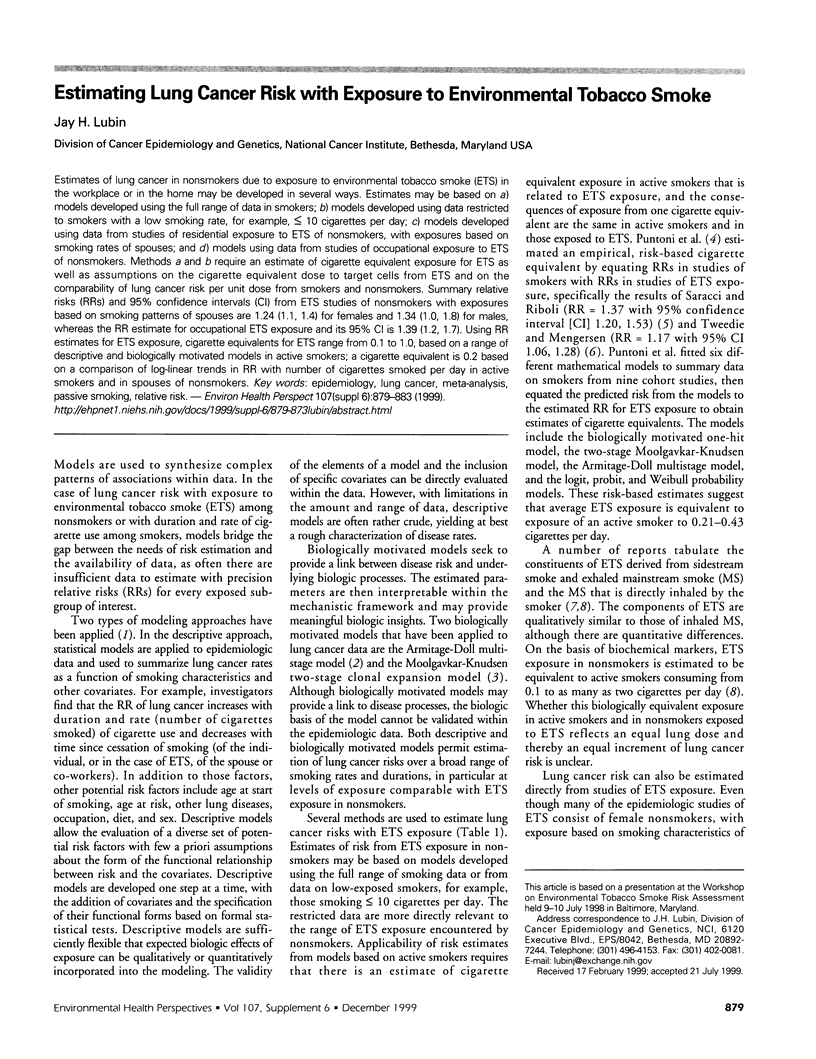
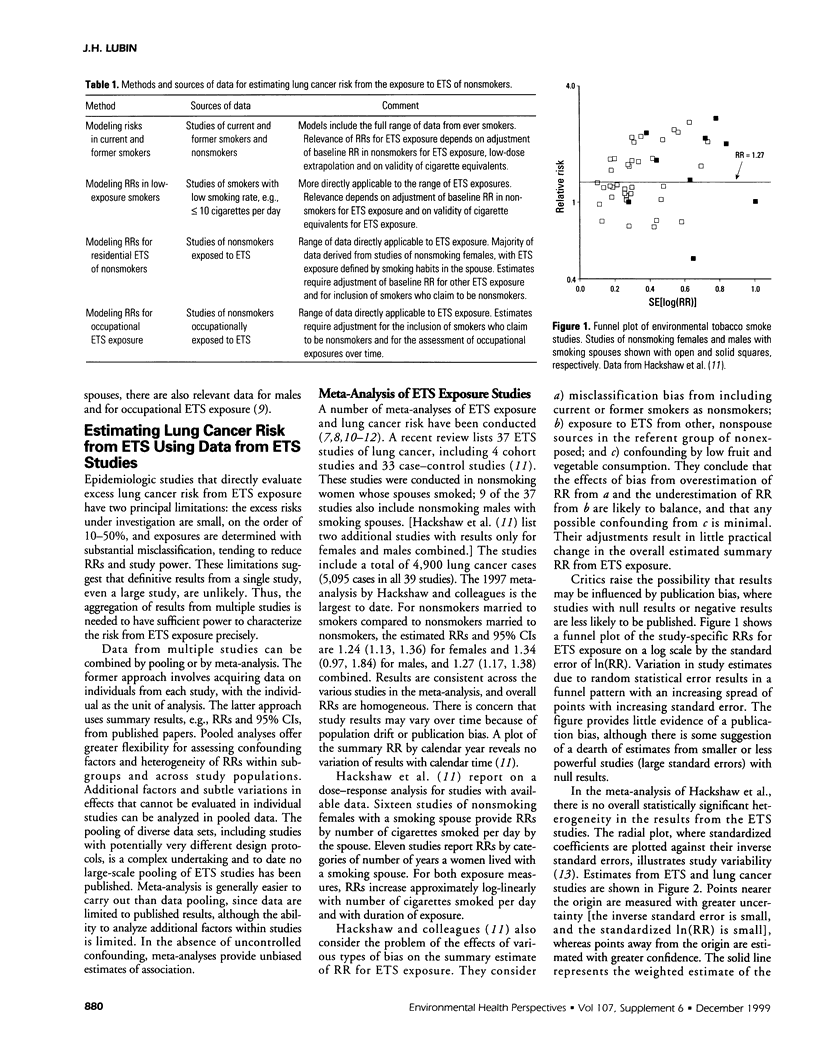
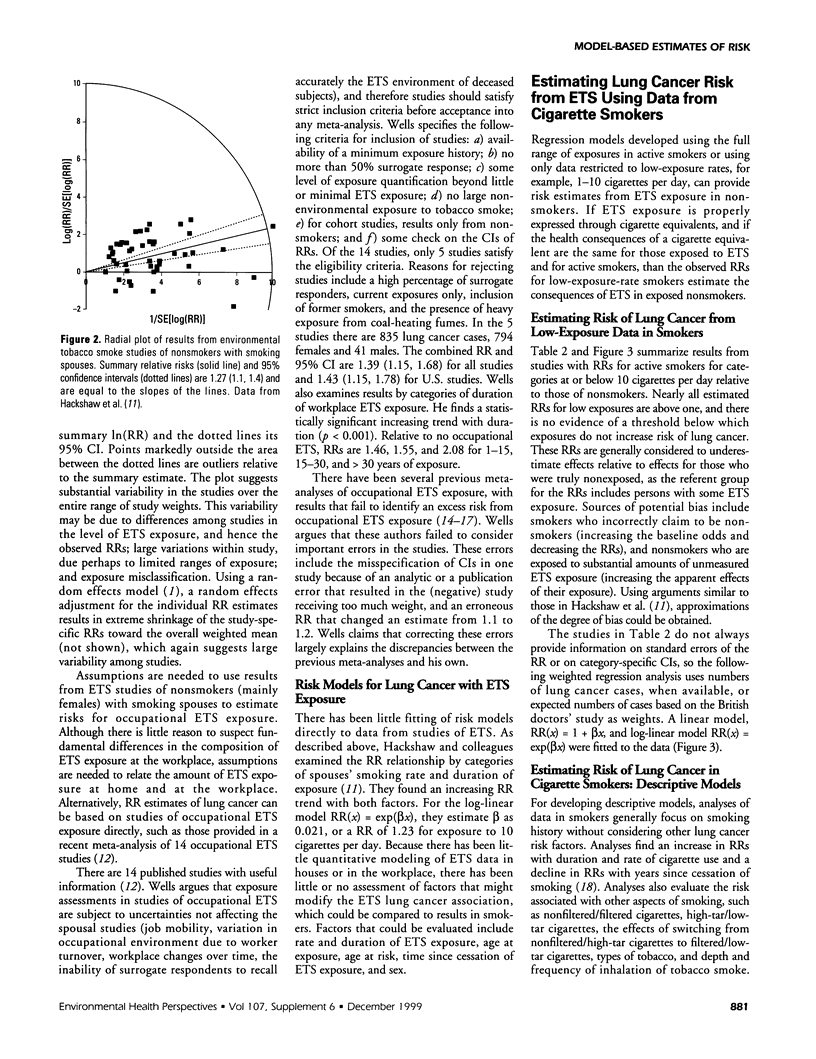
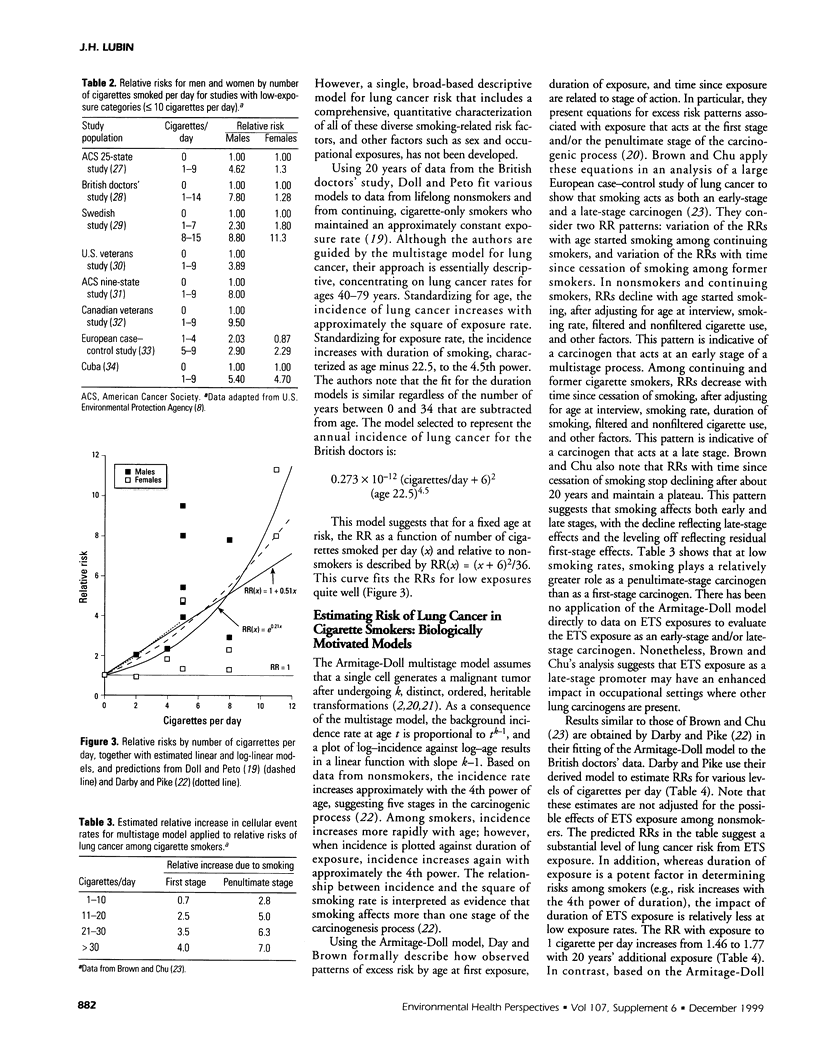
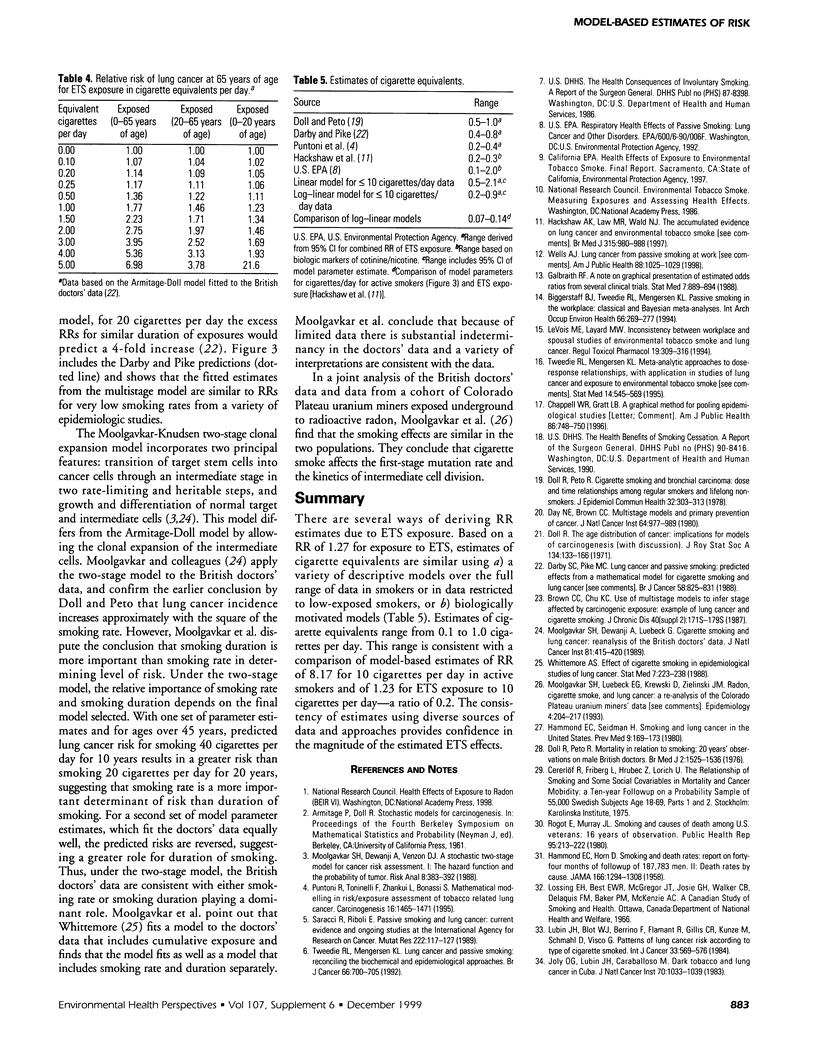
Selected References
These references are in PubMed. This may not be the complete list of references from this article.
- Biggerstaff B. J., Tweedie R. L., Mengersen K. L. Passive smoking in the workplace: classical and Bayesian meta-analyses. Int Arch Occup Environ Health. 1994;66(4):269–277. doi: 10.1007/BF00454366. [DOI] [PubMed] [Google Scholar]
- Brown C. C., Chu K. C. Use of multistage models to infer stage affected by carcinogenic exposure: example of lung cancer and cigarette smoking. J Chronic Dis. 1987;40 (Suppl 2):171S–179S. doi: 10.1016/s0021-9681(87)80020-6. [DOI] [PubMed] [Google Scholar]
- Chappell W. R., Gratt L. B. A graphical method for pooling epidemiological studies. Am J Public Health. 1996 May;86(5):748–750. doi: 10.2105/ajph.86.5.748. [DOI] [PMC free article] [PubMed] [Google Scholar]
- Darby S. C., Pike M. C. Lung cancer and passive smoking: predicted effects from a mathematical model for cigarette smoking and lung cancer. Br J Cancer. 1988 Dec;58(6):825–831. doi: 10.1038/bjc.1988.319. [DOI] [PMC free article] [PubMed] [Google Scholar]
- Day N. E., Brown C. C. Multistage models and primary prevention of cancer. J Natl Cancer Inst. 1980 Apr;64(4):977–989. [PubMed] [Google Scholar]
- Doll R., Peto R. Cigarette smoking and bronchial carcinoma: dose and time relationships among regular smokers and lifelong non-smokers. J Epidemiol Community Health. 1978 Dec;32(4):303–313. doi: 10.1136/jech.32.4.303. [DOI] [PMC free article] [PubMed] [Google Scholar]
- Doll R., Peto R. Mortality in relation to smoking: 20 years' observations on male British doctors. Br Med J. 1976 Dec 25;2(6051):1525–1536. doi: 10.1136/bmj.2.6051.1525. [DOI] [PMC free article] [PubMed] [Google Scholar]
- Galbraith R. F. A note on graphical presentation of estimated odds ratios from several clinical trials. Stat Med. 1988 Aug;7(8):889–894. doi: 10.1002/sim.4780070807. [DOI] [PubMed] [Google Scholar]
- Hackshaw A. K., Law M. R., Wald N. J. The accumulated evidence on lung cancer and environmental tobacco smoke. BMJ. 1997 Oct 18;315(7114):980–988. doi: 10.1136/bmj.315.7114.980. [DOI] [PMC free article] [PubMed] [Google Scholar]
- Hammond E. C., Seidman H. Smoking and cancer in the United States. Prev Med. 1980 Mar;9(2):169–174. doi: 10.1016/0091-7435(80)90071-7. [DOI] [PubMed] [Google Scholar]
- Joly O. G., Lubin J. H., Caraballoso M. Dark tobacco and lung cancer in Cuba. J Natl Cancer Inst. 1983 Jun;70(6):1033–1039. [PubMed] [Google Scholar]
- LeVois M. E., Layard M. W. Inconsistency between workplace and spousal studies of environmental tobacco smoke and lung cancer. Regul Toxicol Pharmacol. 1994 Jun;19(3):309–316. doi: 10.1006/rtph.1994.1026. [DOI] [PubMed] [Google Scholar]
- Lubin J. H., Blot W. J., Berrino F., Flamant R., Gillis C. R., Kunze M., Schmahl D., Visco G. Patterns of lung cancer risk according to type of cigarette smoked. Int J Cancer. 1984 May 15;33(5):569–576. doi: 10.1002/ijc.2910330504. [DOI] [PubMed] [Google Scholar]
- Moolgavkar S. H., Dewanji A., Luebeck G. Cigarette smoking and lung cancer: reanalysis of the British doctors' data. J Natl Cancer Inst. 1989 Mar 15;81(6):415–420. doi: 10.1093/jnci/81.6.415. [DOI] [PubMed] [Google Scholar]
- Moolgavkar S. H., Dewanji A., Venzon D. J. A stochastic two-stage model for cancer risk assessment. I. The hazard function and the probability of tumor. Risk Anal. 1988 Sep;8(3):383–392. doi: 10.1111/j.1539-6924.1988.tb00502.x. [DOI] [PubMed] [Google Scholar]
- Moolgavkar S. H., Luebeck E. G., Krewski D., Zielinski J. M. Radon, cigarette smoke, and lung cancer: a re-analysis of the Colorado Plateau uranium miners' data. Epidemiology. 1993 May;4(3):204–217. [PubMed] [Google Scholar]
- Puntoni R., Toninelli F., Zhankui L., Bonassi S. Mathematical modelling in risk/exposure assessment of tobacco related lung cancer. Carcinogenesis. 1995 Jul;16(7):1465–1471. doi: 10.1093/carcin/16.7.1465. [DOI] [PubMed] [Google Scholar]
- Rogot E., Murray J. L. Smoking and causes of death among U.S. veterans: 16 years of observation. Public Health Rep. 1980 May-Jun;95(3):213–222. [PMC free article] [PubMed] [Google Scholar]
- Saracci R., Riboli E. Passive smoking and lung cancer: current evidence and ongoing studies at the International Agency for Research on Cancer. Mutat Res. 1989 Feb;222(2):117–127. doi: 10.1016/0165-1218(89)90025-6. [DOI] [PubMed] [Google Scholar]
- Tweedie R. L., Mengersen K. L. Meta-analytic approaches to dose-response relationships, with application in studies of lung cancer and exposure to environmental tobacco smoke. 1995 Mar 15-Apr 15Stat Med. 14(5-7):545–569. doi: 10.1002/sim.4780140514. [DOI] [PubMed] [Google Scholar]
- Wells A. J. Lung cancer from passive smoking at work. Am J Public Health. 1998 Jul;88(7):1025–1029. doi: 10.2105/ajph.88.7.1025. [DOI] [PMC free article] [PubMed] [Google Scholar]
- Whittemore A. S. Effect of cigarette smoking in epidemiological studies of lung cancer. Stat Med. 1988 Jan-Feb;7(1-2):223–238. doi: 10.1002/sim.4780070124. [DOI] [PubMed] [Google Scholar]


